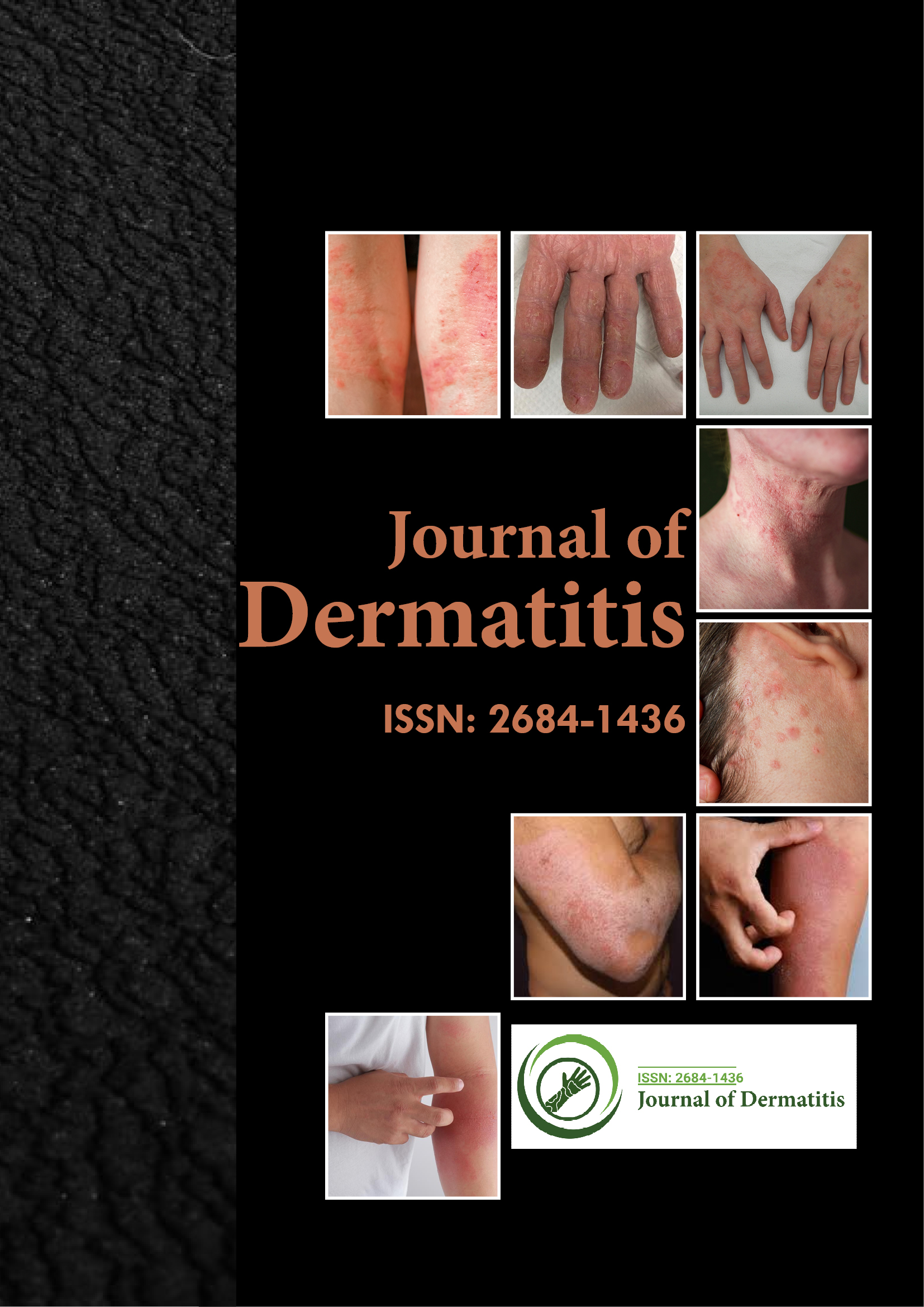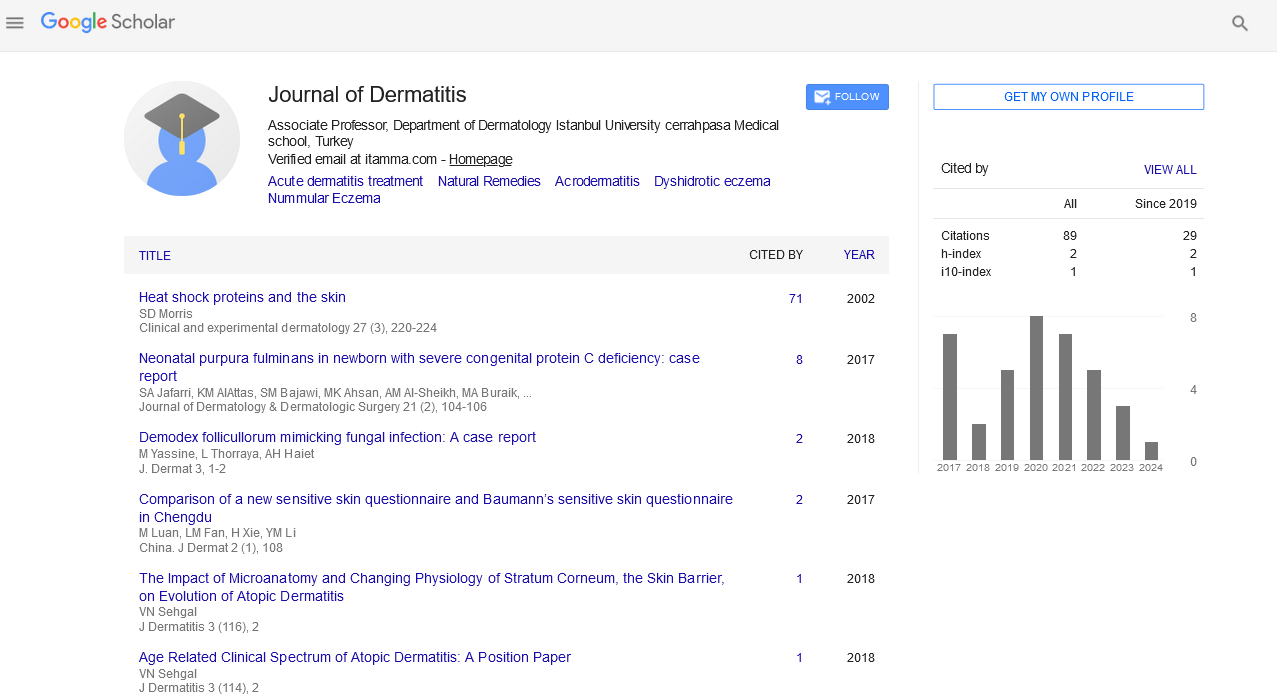Indexed In
- RefSeek
- Hamdard University
- EBSCO A-Z
- Euro Pub
- Google Scholar
Useful Links
Share This Page
Journal Flyer

Open Access Journals
- Agri and Aquaculture
- Biochemistry
- Bioinformatics & Systems Biology
- Business & Management
- Chemistry
- Clinical Sciences
- Engineering
- Food & Nutrition
- General Science
- Genetics & Molecular Biology
- Immunology & Microbiology
- Medical Sciences
- Neuroscience & Psychology
- Nursing & Health Care
- Pharmaceutical Sciences
Opinion - (2025) Volume 10, Issue 1
Patterns of Skin Dryness in Women Affected by Chronic Nodular Skin Conditions
Sinan Ayhan*Received: 25-Feb-2025, Manuscript No. JOD-25-29129; Editor assigned: 27-Feb-2025, Pre QC No. JOD-25-29129 (PQ); Reviewed: 13-Mar-2025, QC No. JOD-25-29129; Revised: 20-Mar-2025, Manuscript No. JOD-25-29129 (R); Published: 27-Mar-2025, DOI: 10.35248/2684-1436.25.10.269
Description
Prurigo Nodularis (PN) is a chronic skin disorder characterized by firm, itchy nodules, often symmetrically distributed on the extensor surfaces of the limbs. Its etiology involves a complex interplay of immune dysfunction, neural sensitization and repetitive mechanical trauma due to scratching. Xerosis cutis, or dry skin, is a frequent clinical observation in patients diagnosed with PN and may intensify pruritus, setting off or perpetuating the itch-scratch cycle.
In women, dermatological sensitivity, hormonal shifts and certain lifestyle factors may contribute to a higher prevalence and intensity of xerosis. Identifying co-factors associated with xerosis in this subgroup can help inform targeted management approaches, particularly in cases where standard treatments for PN yield limited success.
Xerosis cutis
Xerosis cutis is characterized by rough, scaly and sometimes cracked skin due to diminished moisture content in the stratum corneum. It may be physiological, such as in older adults due to reduced sebaceous and sweat gland function, or pathological, resulting from systemic conditions, topical irritants, or skin barrier dysfunction.
In PN, xerosis may not only be a background feature but also contribute to disease exacerbation. It facilitates pruritus, encourages mechanical damage through scratching, and impairs skin regeneration. The recognition of xerosis as more than a secondary finding in PN has grown, particularly in light of emerging data linking skin barrier changes to neuropathic and inflammatory pathways.
Epidemiology and gender considerations
Although PN affects both sexes, women tend to present earlier and may report more intense symptoms. Xerosis is also more commonly reported among women, particularly in postmenopausal age groups, possibly due to estrogen decline, which affects lipid production in the skin.
The increased visibility and texture changes associated with xerosis may also lead women to seek medical attention earlier, resulting in a higher detection rate of the condition in this subgroup.
Co-factors contributing to xerosis
Hormonal fluctuations: Postmenopausal women frequently report increased skin dryness, likely due to decreased estrogen levels, which influence collagen production and sebaceous gland activity. These changes contribute to increased skin fragility and susceptibility to irritation, particularly in those already predisposed to chronic dermatoses like PN.
Psychological stress: Chronic psychological stress is frequently observed in PN and is also implicated in barrier disruption. Stress-induced cortisol secretion interferes with epidermal lipid synthesis, further exacerbating xerosis. Women, particularly in caregiving roles or under occupational strain, may be disproportionately affected.
Environmental exposures: Dry, cold climates and low-humidity indoor environments strip moisture from the skin. Frequent bathing, especially in hot water or using perfumed soaps, also contributes to the worsening of xerosis. These factors are often underappreciated in patient histories but can play a significant role in symptom escalation.
Systemic comorbidities: Women with conditions such as hypothyroidism, diabetes mellitus and atopic diathesis are more prone to develop xerosis. In particular, subclinical hypothyroidism is common among middle-aged women and may contribute to both dry skin and heightened sensory symptoms.
Nutritional factors: Deficiencies in essential fatty acids, vitamin A, vitamin D and zinc impair epidermal barrier repair and hydration retention. Dietary habits and restrictive eating patterns, which may be more common in certain female populations, can exacerbate such deficiencies.
Implications for quality of life
The presence of xerosis in PN is more than a cosmetic or secondary concern. In affected women, it compounds the psychological and sensory burden of the disease. Studies show that skin dryness and pruritus negatively influence sleep, social interaction, and self-perception, particularly when affecting visible areas.
Xerosis cutis is a common and clinically relevant finding in women with prurigo nodularis. It influences both the perception and persistence of pruritus, contributing to the vicious cycle of itch and scratch that defines this condition. Recognizing associated co-factors ranging from hormonal shifts to environmental and nutritional contributors can lead to a more individualized and effective approach to treatment. By prioritizing skin barrier support, clinicians may achieve more stable disease control and better overall outcomes for women affected by this challenging dermatological condition.
Citation: Ayhan S (2025). Patterns of Skin Dryness in Women Affected by Chronic Nodular Skin Conditions. J Dermatitis. 10:269.
Copyright: © 2025 Ayhan S. This is an open-access article distributed under the terms of the Creative Commons Attribution License, which permits unrestricted use, distribution, and reproduction in any medium, provided the original author and source are credited.

